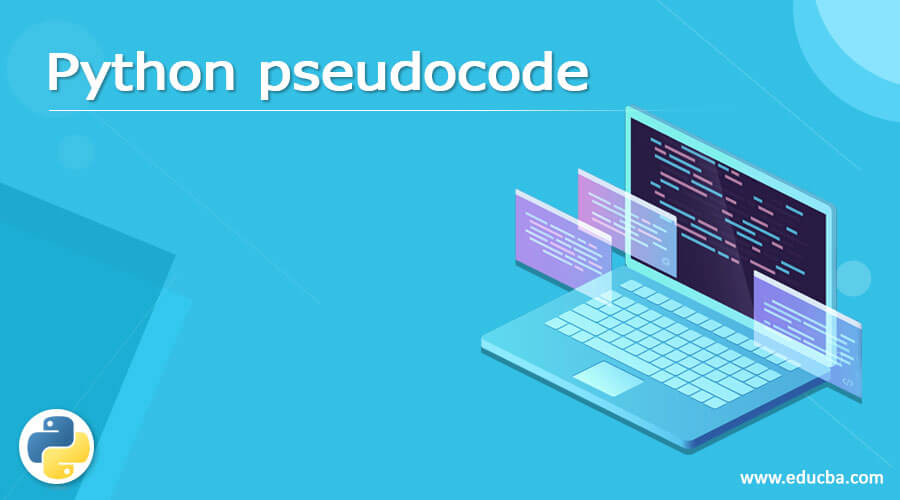Updated May 20, 2023

Introduction to Python pseudocode
Python pseudocode is more like an algorithmic representation of the code involved. This means when a code is expected to be formulated it cannot be directly drafted. The code will need to be first generated into a Python pseudocode, and then it needs to be formulated into an actual code. This process of formulating an English sentence-like algorithmic representation is what a Python pseudocode means to be. In simple terms, it is a syntax-free representation of code. So, it does not involve any code in it.
It must be a very close representation of the algorithmic logic. It must be such that each line of the Python pseudocode can be proportionally translated to the actual code. For non-technical participants, it facilitates speedy code resolution. These are the key advantages of using Python pseudocode in programming. So, the primary description to keep in the sense of simple terms is that Python pseudocode is a syntax-free representation of code. So, it does not involve any actual code in it.
Key points
Whenever there is a need to connect with people from other domains, Python pseudocode will be the best element to bridge communication. Apart from the technical aspect, which is expected to be coded, there will be a need to code about some specific domains. Specifically, programmers must connect with mathematicians, financial experts, biotechnologists, healthcare specialists, or any other specific domain experts for business reasons. For example, if biotechnology-based software is expected to be created, then there will be a need to connect with biotechnologists to build the software. We need to ensure the communication between the developer and the other domain expert needs to be mutually understandable and smooth. This can be achieved using Python pseudocode-based algorithms, which keep the understanding of the business expert and the technical programmer on the same page.
One of the most hectic processes in software development with languages like Python is converting the HLD to business logic and code. Converting the business logic to code is the most hectic process in Python-based application development environments. This section may raise numerous business issues that the business person and programmer must resolve. However, introducing an additional layer of Python pseudocode between the business logic layer and actual code simplifies the coding difficulties significantly. So, writing pseudocode helps to convert algorithmic representations to existing code comfortably.
Having pseudocode in the Python application-building process will help to build documentation for the application quickly. This is another very critical aspect of having pseudocodes in place. So, no matter the domain, complexity, or technology used in an application, it’s crucial to associate documentation with it. Documentation at the application level provides a good understanding of the related application type and the framing of its business logic. You can only realize this with the strong pseudocode involved in it.
Documentation plays a crucial role as a key capability for any application. Based on the involved pseudocode, you can only kick-start and progress the documentation smoothly. The Presence of pseudocode in the application makes the application documentation process comparatively easy to perform. This is among the key advantages of building pseudocode in Python-level applications.
Another key portion of developing python level pseudocode is their capability to fix issues, concerns, and bugs raised within the application. So this means that Python application bugs and debugging of these bugs are prevalent. Bugs can generate and create easily, but fixing these bugs is critical. When the code involved is very dense and too long, then identifying the bugs generated in an application becomes very difficult. Using the pseudocode of these applications can handle this difficulty sophisticatedly. Referring to the pseudocode eases the bug detection and fixing process, so this is another crucial reason to have pseudocodes generated and written in Python-based applications.
Five major Protocols in Python pseudocode
- You must write Python pseudocode line by line, representing each involved statement as a single line.
- Just as you use indentations in Python code, you should also prefer indentations in Python pseudocode.
- Ensure that each statement of the pseudocode is simple and easy to understand.
- Make sure the pseudocode’s first word is always in uppercase letters.
- Ensure to use periods and delimiters wherever needed.
Examples
Retrieve the number that the user wants to reverse and store it into the variable ‘sample_number.’
Initialize the temporary variable test_number as zero.
Perform a while loop until the sample_number variable is more significant than zero.
Modulus the sample_number variable by 10 and store the remainder.
Multiply the temporary number of test_number by 10 and add the returned value to the remainder.
Print the generated test_number onto the console.
Code:
sample_number = int(input("Number to be reversed: "))
test_number = 0
while(sample_number>0):
remainder_number = sample_number % 10
test_number = (test_number * 10) + remainder_number
sample_number = sample_number//10
print("Value after reverse : {}".format(test_number))Output:
Conclusion
The Presence of pseudocode helps the application-level coding a more accessible aspect to develop upon. The example above shows the coding aspect’s enhanced flexibility when we base it on the pseudocode that we draft before the actual code. It should be a legal requirement to use pseudocode for all application-level programming.
Recommended Articles
We hope that this EDUCBA information on “Python pseudocode” was beneficial to you. You can view EDUCBA’s recommended articles for more information.


